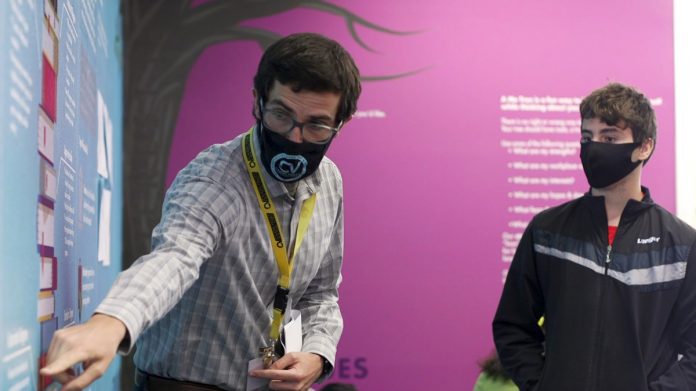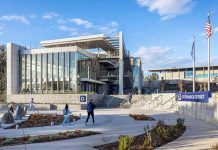Research indicates that students’ career pathways are heavily influenced by the people around them. In order to ensure all students have equal access to high-quality career development, San Diego Workforce Partnership and Cajon Valley School District joined forces to create a career center at Cajon Valley Middle School. The Launch Pad simplifies career exploration and experimentation to inspire the next generation of the region’s workforce.
Sarah Burns, San Diego Workforce Partnership research application director, said Launch Pad is a middle school library transformed into a reimagined career center. She said choosing a middle school was dual purposed.
She said students can go through the experience, interact with various learning installations and activities and answer three questions about themselves. Who am I? Who may I become? How can I get there?
“It is to help build that muscle early of needing to make decisions about high school next year,” she said. “It starts to give them a path. It starts them to work with professionals in the field.”
Burns said the second piece to Launch Pad is that it is open to families.
“Families come in and access the same activities using the same support and reflecting on their careers and get connected to the resources that we have at the SDWP through our local career centers,” she said. “Placing access to those resources at a trusted center of the community like a school, where we know parents are connecting already, we believe will be an effective model reaching those parents in need. Especially right now during COVID when there is a heighten need.”
Edward Hidalgo, Cajon Valley School District chief innovation and engagement officer, said though Launch Pad is new, the work within it is not. He said the district began to integrate a career development framework that begins in kindergarten four years ago.
“It is for every child, every grade, every year,” he said. “It is very new in the sense that career development typically does not happen in early grades. Typically, it happens in high school if it happens at all.”
Hidalgo said the “deeper essence” of the work is the idea of building occupational identity at an early age. He said to do that they use the Holland Code, the most researched vocational typologies developed in the early ’60s.
“It is a way to organize your interests through six themed interest categories,” he said. “Through this process, students are beginning to understand and claim their interest theme in areas like hands-on doing, realistic, artistic, creative self-expression, investigative using math and science to solve problems.”
Hidalgo said through the understanding of self, access to curriculum, contacts, experiences, and projects, students can have more agency in the choice of things they are doing.
“Agency [student choice] is an important word in the educational landscape,” he said. “When you can give students, agency based on who they are and an understanding of their unique interests and talents, it is a powerful thing. Launch Pad is an accelerator of that work tapping into our classrooms.”
Burns said SDWP has never taken the step of integrating its research on the workforce market with a school in creating a career pathway for students.
“So students have knowledge of what is happening in our local economy and what the options are,” she said. “We show occupations and how they align with interests and we also call on El Cajon companies and have activities that go along with this. They research a company. They see how far away it is. We also integrated it around essential skills like communication and collaboration that, when we talk to employers, are the most important things they look for when they are hiring.”
Burns said with Launch Pad still a new concept, and the inability to hold events and have speakers, that are no companies connected to Launch Pad at this time, but SDWP and the district are reaching out to local businesses to become involved.
She said local businesses creating a video tour of their operations, the careers available and seeing people at work in a career is a good example.
“For interested businesses I would tell them this is your future workforce,” she said. “This is your talent pool, and you have the opportunity to get in front of them at a young age when all kids are doing is thinking about what the want to be when they grow up. They are making these decisions on what they see in front of them. It is imperative for businesses when thinking on how they want to grow in the future.”
Hidalgo said this is an opportunity for businesses to share what they do with young people. He said youth began to “foreclose” as early as 7-years-old.
“There are many stereotypes, whether it is gender or race based because of things they see on their phone, TV, what they read in books that start to cancel out their beliefs about who they can become,” he said. “We help students find out who they are, who they might want to become, and we help the parents start to develop that same language so they can better understand their children. Meanwhile, helping parents upskill, reskill and advance their own careers based on this information. Then we bring employers in to talk about opportunities, the future of work, what we are doing now, where trends are heading.”
Hidalgo said it is piecing all these pieces together, to ensure there is a workforce to make a vibrant society.
“It is important for parents to know that they are their child’s first career coach,” he said. “Their involvement in this process in essential. We understand the communities we serve in El Cajon. We understand a zip code destiny and we are trying to break those things for both the students and the parents.”














